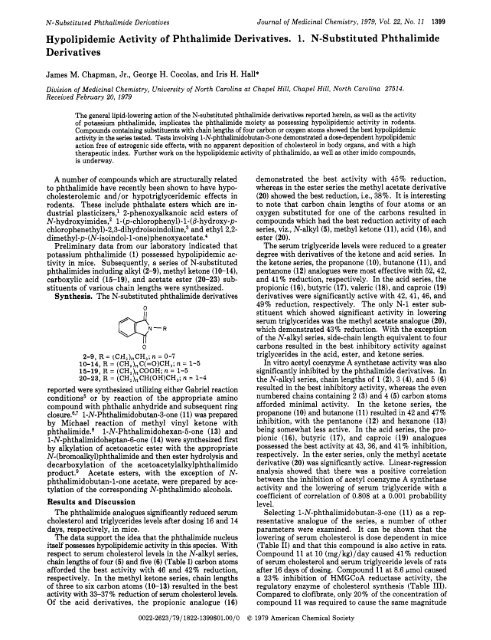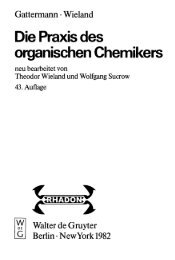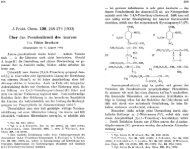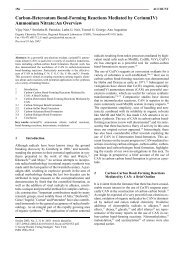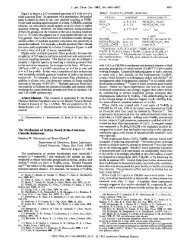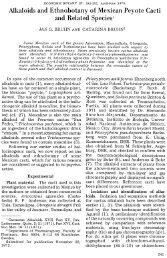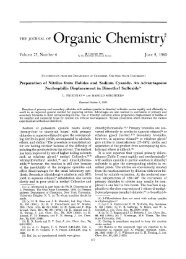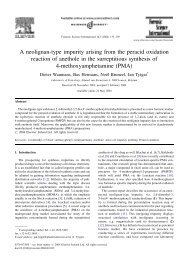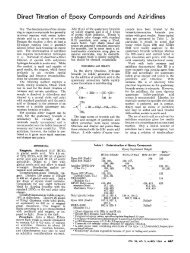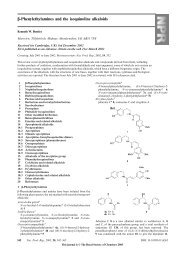n-substituted.phthal.. - mdma - Index of
n-substituted.phthal.. - mdma - Index of
n-substituted.phthal.. - mdma - Index of
You also want an ePaper? Increase the reach of your titles
YUMPU automatically turns print PDFs into web optimized ePapers that Google loves.
N-Substituted Phthalimide Derivatives<br />
Journal <strong>of</strong> Medicinal Chemistry, 1979, Vol. 22, No. 11 1399<br />
Hypolipidemic Activity <strong>of</strong> Phthalimide Derivatives. 1. N-Substituted Phthalimide<br />
Derivatives<br />
James M. Chapman, Jr., George H. Cocolas, and Iris H. Hall*<br />
Division <strong>of</strong> Medicinal Chemistry, University <strong>of</strong> North Carolina at Chapel Hill, Chapel Hill, North Carolina 27514.<br />
Received February 20, 1979<br />
The general lipid-lowering action <strong>of</strong> the N-<strong>substituted</strong> <strong>phthal</strong>imide derivatives reported herein, as well as the activity<br />
<strong>of</strong> potassium <strong>phthal</strong>imide, implicates the <strong>phthal</strong>imide moiety as possessing hypolipidemic activity in rodents.<br />
Compounds containing substituenh with chain lengths <strong>of</strong> four carbon or oxygen atoms showed the best hypolipidemic<br />
activity in the series tested. Tesh involving l-N-<strong>phthal</strong>imidobutan-3-one demonstrated a dose-dependent hypolipidemic<br />
action free <strong>of</strong> estrogenic side effects, with no apparent deposition <strong>of</strong> cholesterol in body organs, and with a high<br />
therapeutic index. Further work on the hypolipidemic activity <strong>of</strong> <strong>phthal</strong>imido, as well as other imido compounds,<br />
is underway.<br />
A number <strong>of</strong> compounds which are structurally related<br />
to <strong>phthal</strong>imide have recently been shown to have hypocholesterolemic<br />
and/or hypotriglyceridemic effects in<br />
rodents, These include <strong>phthal</strong>ate esters which are industrial<br />
plasticizers,' 2-phenoxyalkanoic acid esters <strong>of</strong><br />
N-hydroxy imides ,2 1 - (p-chlor ophenyl) - 1 - (0- hydroxy-pchlorophenethyl)-2,3-dihydroisoindoline,3<br />
and ethyl 2,2dimethyl-p-(N-isoindol-l-one)phenoxyacetate.4<br />
Preliminary data from our laboratory indicated that<br />
potassium <strong>phthal</strong>imide (1) possessed hypolipidemic activity<br />
in mice. Subsequently, a series <strong>of</strong> N-<strong>substituted</strong><br />
<strong>phthal</strong>imides including alkyl (2-9), methyl ketone (1O-14),<br />
carboxylic acid (15-191, and acetate ester (20-23) substituents<br />
<strong>of</strong> various chain lengths were synthesized.<br />
Synthesis. The N-<strong>substituted</strong> <strong>phthal</strong>imide derivatives<br />
"-. \<br />
0<br />
2-9, R = (CH,),CH,; n = 0-7<br />
10-14, R = (CH,),C(=O)CH,; n = 1-5<br />
15-19, R = (CH,),COOH; n = 1-5<br />
20-23, R = (CH,),CH(OH)CH,; n = 1-4<br />
reported were synthesized utilizing either Gabriel reaction<br />
conditions5 or by reaction <strong>of</strong> the appropriate amino<br />
compound with <strong>phthal</strong>ic anhydride and subsequent ring<br />
l-N-Phthalimidobutan-3-one (1 1) was prepared<br />
by Michael reaction <strong>of</strong> methyl vinyl ketone with<br />
<strong>phthal</strong>imide.8 l-N-Phthalimidohexan-&one (13) and<br />
l-N-<strong>phthal</strong>imidoheptan-6-one (14) were synthesized first<br />
by alkylation <strong>of</strong> acetoacetic ester with the appropriate<br />
N-(bromoalky1)<strong>phthal</strong>imide and then ester hydrolysis and<br />
decarboxylation <strong>of</strong> the acetoacetylalkyl<strong>phthal</strong>imido<br />
prod~ct.~ Acetate esters, with the exception <strong>of</strong> N-<br />
<strong>phthal</strong>imidobutan-l-one acetate, were prepared by acetylation<br />
<strong>of</strong> the corresponding N-<strong>phthal</strong>imido alcohols.<br />
Results and Discussion<br />
The <strong>phthal</strong>imide analogues significantly reduced serum<br />
cholesterol and triglycerides levels after dosing 16 and 14<br />
days, respectively, in mice.<br />
The data support the idea that the <strong>phthal</strong>imide nucleus<br />
itself possesses hypolipidemic activity in this species. With<br />
respect to serum cholesterol levels in the N-alkyl series,<br />
chain lengths <strong>of</strong> four (5) and five (6) (Table I) carbon atoms<br />
afforded the best activity with 46 and 42% reduction,<br />
respectively. In the methyl ketone series, chain lengths<br />
<strong>of</strong> three to six carbon atoms (10-13) resulted in the best<br />
activity with 33-37% reduction <strong>of</strong> serum cholesterol levels.<br />
Of the acid derivatives, the propionic analogue (16)<br />
demonstrated the best activity with 45% reduction,<br />
whereas in the ester series the methyl acetate derivative<br />
(20) showed the best reduction, Le., 38%. It is interesting<br />
to note that carbon chain lengths <strong>of</strong> four atoms or an<br />
oxygen <strong>substituted</strong> for one <strong>of</strong> the carbons resulted in<br />
compounds which had the best reduction activity <strong>of</strong> each<br />
series, viz., N-alkyl (5), methyl ketone (ll), acid (16), and<br />
ester (20).<br />
The serum triglyceride levels were reduced to a greater<br />
degree with derivatives <strong>of</strong> the ketone and acid series. In<br />
the ketone series, the propanone (lo), butanone (ll), and<br />
pentanone (12) analogues were most effective with 52,42,<br />
and 41% reduction, respectively. In the acid series, the<br />
propionic (16), butyric (17), valeric (18), and caproic (19)<br />
derivatives were significantly active with 42, 41, 46, and<br />
49% reduction, respectively. The only N-1 ester substituent<br />
which showed significant activity in lowering<br />
serum triglycerides was the methyl acetate analogue (20),<br />
which demonstrated 43 % reduction. With the exception<br />
<strong>of</strong> the N-alkyl series, side-chain length equivalent to four<br />
carbons resulted in the best inhibitory activity against<br />
triglycerides in the acid, ester, and ketone series.<br />
In vitro acetyl coenzyme A synthetase activity was also<br />
significantly inhibited by the <strong>phthal</strong>imide derivatives. In<br />
the N-alkyl series, chain lengths <strong>of</strong> 1 (2), 3 (4), and 5 (6)<br />
resulted in the best inhibitory activity, whereas the even<br />
numbered chains containing 2 (3) and 4 (5) carbon atoms<br />
afforded minimal activity. In the ketone series, the<br />
propanone (10) and butanone (11) resulted in 42 and 47%<br />
inhibition, with the pentanone (12) and hexanone (13)<br />
being somewhat less active. In the acid series, the propionic<br />
(16), butyric (17), and caproic (19) analogues<br />
possessed the best activity at 43, 36, and 41 % inhibition,<br />
respectively. In the ester series, only the methyl acetate<br />
derivative (20) was significantly active. Linear-regression<br />
analysis showed that there was a positive correlation<br />
between the inhibition <strong>of</strong> acetyl coenzyme A synthetase<br />
activity and the lowering <strong>of</strong> serum triglyceride with a<br />
coefficient <strong>of</strong> correlation <strong>of</strong> 0.808 at a 0.001 probability<br />
level.<br />
Selecting l-N-<strong>phthal</strong>imidobutan-3-one (1 1) as a representative<br />
analogue <strong>of</strong> the series, a number <strong>of</strong> other<br />
parameters were examined. It can be shown that the<br />
lowering <strong>of</strong> serum cholesterol is dose dependent in mice<br />
(Table 11) and that this compound is also active in rats.<br />
Compound 11 at 10 (mg/kg)/day caused 41% reduction<br />
<strong>of</strong> serum cholesterol and serum triglyceride levels <strong>of</strong> rats<br />
after 16 days <strong>of</strong> dosing. Compound 11 at 8.6 pmol caused<br />
a 23% inhibition <strong>of</strong> HMGCoA reductase activity, the<br />
regulatory enzyme <strong>of</strong> cholesterol synthesis (Table 111).<br />
Compared to cl<strong>of</strong>ibrate, only 20% <strong>of</strong> the concentration <strong>of</strong><br />
compound 11 was required to cause the same magnitude<br />
0022-262317911822-1399$01.00/0 0 1979 American Chemical Society
1400 Journal <strong>of</strong> Medicinal Chemistry, 1979, Vol. 22, No. 11<br />
Table I. Effects <strong>of</strong> Phthalimide Analogues on Serum LiDids in Micea IN = 6)<br />
Chapman, Cocolas, Hall<br />
% control<br />
no. compound<br />
serum cholesterol<br />
9th day 16th day<br />
serum triglycerides<br />
in vitro<br />
AcCoA<br />
synthetase<br />
obsd ~p<br />
or bp, C lit. mp or bp,<br />
(mmHg) "C (mmHg)<br />
lit.<br />
ref<br />
1 uotassium Dhthalimide<br />
2 k-methyl<strong>phthal</strong>imide<br />
3 N-ethyl<strong>phthal</strong>imide<br />
4 N-n-propy l<strong>phthal</strong>imide<br />
5 N-n-butyl<strong>phthal</strong>imide<br />
6 N-n-pentyl<strong>phthal</strong>imide<br />
7 N-n- hexyl<strong>phthal</strong>imide<br />
63% 6e<br />
74 + 4e<br />
83+ 4e<br />
96+ 4<br />
72+ 1Oe<br />
76t 5e<br />
96 i 5<br />
78t 3d<br />
74t 8d<br />
76+ 2e<br />
74i 5<br />
54t 6e<br />
58i 3e<br />
66+ 4e<br />
88+ 4d<br />
68+<br />
87 r 5d<br />
81k 9d<br />
82+ 16<br />
75i 16c<br />
84+ 8d<br />
78 c 6e<br />
66i 12e<br />
82 + 5e<br />
67 + 3e<br />
82 i 7d<br />
68 i 6e<br />
71 5 12<br />
137-139<br />
77-78.5<br />
63.5-65<br />
110-116<br />
(0.12)<br />
114-115<br />
(0.028)<br />
118-122<br />
133.5-134<br />
79<br />
64.5<br />
100-104<br />
(0.03)<br />
175 (14)<br />
140-146<br />
26<br />
26<br />
27<br />
6<br />
28<br />
6<br />
8<br />
9<br />
10<br />
11<br />
12<br />
13<br />
14<br />
15<br />
16<br />
17<br />
18<br />
19<br />
20<br />
21<br />
22<br />
23<br />
24<br />
N-n-heptyl<strong>phthal</strong>imide<br />
99 f 7<br />
N-n-octyl<strong>phthal</strong>imide 101 + 7<br />
1-N-<strong>phthal</strong>imidopropan-2-one 80 i 16b<br />
1-N-<strong>phthal</strong>imidobutan-3-one 67 i lle<br />
1-N-<strong>phthal</strong>imidopentan-4-one 71 t 6e<br />
1-N-<strong>phthal</strong>imidohexan-5-one 65 t ge<br />
1-N-<strong>phthal</strong>imidoheptan-6-one 71 + 6e<br />
2-N-<strong>phthal</strong>imidoacetic acid 76i 7e<br />
3-N-<strong>phthal</strong>imidopropionic acid 74 5 7e<br />
4-N-pht halimidobutyric acid BO+ 7e<br />
5-N-<strong>phthal</strong>imidovaleric acid 83 + gd<br />
6-N-<strong>phthal</strong>imidocaproic acid 81 + 6e<br />
N-p ht halimi dome thy1 acetate 61 + ge<br />
N-<strong>phthal</strong>imidoethyl acetate 93+ 13<br />
N-<strong>phthal</strong>imidopropan-1-01 102 i 4<br />
acetate<br />
N-<strong>phthal</strong>imidobutan-1-01 93 + 9<br />
acetate<br />
1% carboxymethylcellulose loor 2f<br />
72r 4e<br />
82i 3d<br />
67 + 12e<br />
63i. 7e<br />
631. 5e<br />
65 f 7e<br />
75t 12c<br />
68 + 7e<br />
55 t 1le<br />
68t 6e<br />
77i 4d<br />
67 t 3e<br />
62+ 4e<br />
95+ le<br />
662 2e<br />
66i 5e<br />
LOO+ llg<br />
84+ 6d<br />
77 t 4e<br />
48+ loe<br />
58+ 7e<br />
59i 13e<br />
77+ 5e<br />
88t 5d<br />
72t 9<br />
58r loe<br />
591 14e<br />
54i 5e<br />
51+ 12e<br />
57 * 2ije<br />
82t 7d<br />
89 + 9<br />
88 t 7b<br />
100 i 6h<br />
71 i 5e<br />
76 t 7e<br />
58 .t 7e<br />
53 k 12e<br />
62+ 3e<br />
68 + 6e<br />
85+ 3e<br />
72+ 12e<br />
57 + 7e<br />
64t 12e<br />
76t<br />
59 + 9e<br />
62k loe<br />
81 t 6e<br />
84 i 2h<br />
83+ 2e<br />
100 i 6'<br />
(0.07) (0.04)<br />
34-35 40<br />
47-48 50-51<br />
124-127 122.9-123.5<br />
114-116 111-113<br />
73.5-75 74.5-75.5<br />
65-67 66-68<br />
71.5-74 71-72<br />
199-202 191-192<br />
152-153 151<br />
117-118 117.5<br />
118.5-120 118.5-119.5<br />
108 107-108<br />
119-121 118<br />
89-90 88.5<br />
63.5-65<br />
58.5-60.5 59.5<br />
29<br />
30<br />
31<br />
8<br />
11<br />
9<br />
32<br />
33<br />
34<br />
35<br />
36<br />
37<br />
38<br />
39<br />
40<br />
a N = number <strong>of</strong> mice per test group = 6.<br />
138 mg %.<br />
10.8 mg/g wet tissue.<br />
Table 11. Serum Lipid Level' after Administering<br />
Test Compounds<br />
% control, T SD<br />
9th day 16th day<br />
<strong>of</strong> dosing <strong>of</strong> dosing<br />
serum cholesterol levels<br />
CF, male mice, ip (N = 8)<br />
11,10 (mg/kg)/day 73 i gd 66t 5d<br />
11, 20 (mg/kg)/day 67t gd 63+ gd<br />
11, 30 (mg/kg)/day 66 i 7d 54 i 6d<br />
cl<strong>of</strong>ibrate,e 20 (mg/kg)/day 98i 12 96i 15<br />
1% CMC, control 1ooi 8 1002 7<br />
control value (mg %) 113 128<br />
Holtzman male rats, PO (N = 6)<br />
11, 1 (mg/kg)/dw<br />
11, 10 (mg/kg)/day<br />
cl<strong>of</strong>ibrate: 10 (mg/kg)/day<br />
1% CMC, control<br />
control value (mg %)<br />
82 i loc<br />
70 ?r gd<br />
97i 15<br />
100.8<br />
73<br />
59 + Bd<br />
106i 9<br />
loo+ 7<br />
77<br />
serum triglycerides levels<br />
Holtzman male rats (N = 6)<br />
11, 10 (mg/kg)/day 59+ 13d<br />
1% CMC, control<br />
control value (mg %)<br />
loor 11<br />
151<br />
* In milligram uercent. D = 0.025. D = 0.01. D =<br />
0.001. e Ethyl 2-(p-chloro~henoxy)-2-m~thylpropion~te<br />
(ATROMID-S), Ayerst.<br />
<strong>of</strong> inhibition <strong>of</strong> HMGCoA reductase activity. However,<br />
a major effect <strong>of</strong> 11 appears to be on AcCoA synthetase<br />
activity, which was inhibited 50% at one-fourth <strong>of</strong> the<br />
concentration required to inhibit HMGCoA reductase<br />
activity 26%. Compound 11 did not suppress the appetite<br />
<strong>of</strong> the animal and thereby reduced serum lipids (Table IV).<br />
Similarly, there was no pronounced change in the body<br />
weight <strong>of</strong> animals over this period. Examination <strong>of</strong> liver<br />
p = 0.25. p = 0.10. p = 0.005. e p = 0.001. f 115 mg %. g 118 mg %.<br />
Table 111. In Vitro Effects <strong>of</strong> Test Compounds on<br />
Regulatory Enzyme for Lipid Synthesis<br />
% control<br />
HMGCoA<br />
reductase act.,<br />
compd (N= 6) i SD<br />
11 (8.6 pmol) 76t Z<br />
cl<strong>of</strong>ibrate (41 @mol) 76t 3a<br />
1% CMC loo+ 36<br />
' p = 0.001. 1 142 065 dpm/g wet weight <strong>of</strong> liver.<br />
homogenates demonstrated that compound 11 caused no<br />
marked alteration <strong>of</strong> nucleic acid, glycogen, protein, or lipid<br />
content <strong>of</strong> liver cells (Table V). When [ 14C]cholesterol<br />
was administered after 16 days <strong>of</strong> dosing with compound<br />
11, it was obvious that there was a substantial reduction<br />
in the deposition <strong>of</strong> labeled cholesterol in the liver (79%),<br />
kidney (40%), and heart (49%) (Table VI). In the<br />
presence <strong>of</strong> the drug, a larger percentage <strong>of</strong> labeled cho-<br />
lesterol was deposited in the large intestine and feces after<br />
24 h, whereas in the control a larger percentage was<br />
concentrated in the stomach and small intestine, suggesting<br />
that 11 accelerates the removal <strong>of</strong> cholesterol through the<br />
feces. LDm studies showed that the therapeutic index <strong>of</strong><br />
this drug was quite high, since at 2 g/kg no deaths were<br />
recorded. The limits <strong>of</strong> solubility <strong>of</strong> the drug has been<br />
reached at this concentration. There was no evidence that<br />
the weight <strong>of</strong> any <strong>of</strong> the major organs was altered after<br />
drug treatment (Table VII). This is not true <strong>of</strong> <strong>phthal</strong>ate<br />
esters, the plasticizers, which have been reported to cause<br />
a large increase in liver weight.1° A number <strong>of</strong> hypoli-<br />
pidemic agents also possess estrogenic characteristics.<br />
With 11 there was no decrease in the size <strong>of</strong> the vas de-<br />
ferens, vesicular, or testes (Table VII) after a 16-day
N-Substituted Phthalimide Derivatives<br />
Table IV.<br />
Effects <strong>of</strong> ComDound 11 on Food Intake and Bodv Weight<br />
Journal <strong>of</strong> Medicinal Chemistry, 1979, Vol. 22, No. 11 1401<br />
av. daily food intake, g/rat rat body wt, g<br />
compound 1-8 days, 9-1 6 days, 0 day,<br />
(N = 6) Ft SD x+- SD F t SD 9th day, F t SD 16th day, x i SD<br />
11 39.4 t 3.8 39.5 i 4.6a 317 i 9 338 i 9 (106%) 348 i 15 (110%)<br />
1% CMC 34.9 i 5.2 34.7 i 3.7 325r 7 341 i 14 (105%) 362 t 5 (116%)<br />
a p = 0.025.<br />
Table V. Percent <strong>of</strong> Control <strong>of</strong> RNA, DNA, Protein,<br />
Glycogen, and Lipid Levels <strong>of</strong> Rat Liver Treated 16<br />
Days with 11 at 10 (mg/kg)/day<br />
glyco- pro-<br />
compd DNA, RNA, lipid, gen, F tein,<br />
(N=6) XiSD F+SD ftSD iSD XtSD<br />
11 104t 11 108i: 19 lOOt 5 94t6 99i5<br />
l%CMC 100 i 18 1002 6 100 t 7 1OOi 8 100 t 3<br />
Table VI. 14C Content <strong>of</strong> Tissues after 16-Days Dosing<br />
with 11 and 24 h after Administration<br />
<strong>of</strong> [ l'C] Cholesterol<br />
control, 1% CMC<br />
treated with 11<br />
dpmk<br />
dpm/g total <strong>of</strong> total % contissue<br />
(N = 6) <strong>of</strong> tissue dpm tissue dpm trol<br />
liver 31425 386525 6655 82522 21.3<br />
kidney 7630 17778 4413 10591 59.5<br />
heart 4916 3849 2018 1968 51.1<br />
chyme 2774 11318 1378 2864 25.3<br />
stomach 166617 324903 17320 45754 14.1<br />
small intestine 35671 363130 1819 18754 5.2<br />
large intestine 3808 18010 1212 60646 336.7<br />
& feces<br />
treatment at 10 (mg/kg)/day, nor did the drug demonstrate<br />
uterotropic effects in ovariectomized immature<br />
females at 20 mg/kg. Furthermore, compound 11 caused<br />
no hypertrophy <strong>of</strong> the adrenal as was seen with many<br />
hypercholesteremic agents.<br />
Experimental Section<br />
Chemistry. Melting points were determined on a Mel-Temp<br />
apparatus and are uncorrected. Infrared spectra were obtained<br />
using a Perkin-Elmer 297 spectrophotometer. NMR data were<br />
obtained using a JEOL FX-60 spectrophotometer. N-Phthalimidoacetic<br />
acid was obtained from Aldrich Chemical Co. and<br />
recrystallized from water. Potassium <strong>phthal</strong>imide and N-(hydroxyethy1)<strong>phthal</strong>imide<br />
were obtained from Eastman Kodak Co.<br />
Elemental analyses were conducted by M-H-W Laboratories,<br />
Phoenix, Ariz., and were within f0.4% <strong>of</strong> theory.<br />
Method A. According to the procedure <strong>of</strong> Abdel-Monem et<br />
al.," 0.11 mol <strong>of</strong> methyl p-toluenesulfonate, ethyl iodide, 1-<br />
bromopentane, chloroacetone, or 5-chloro-2-pentanone was added<br />
to 0.1 mol <strong>of</strong> potassium <strong>phthal</strong>imide in DMF and heated to 100<br />
OC for 8 h to afford compound 2 (41%), 3 (63%), 6 (51%), 10<br />
(50%), or 12 (12%).<br />
Method B. Equimolar amounts <strong>of</strong> <strong>phthal</strong>ic anhydride and a<br />
primary amine were mixed in toluene and heated according to<br />
the method <strong>of</strong> Sterk et al.6 to synthesize compounds 4 (79%), 5<br />
(88%), 7 (83%), 8 (61%), 9 (85%), 15 (go%), 16 (39%), 17 (75%),<br />
18 (70%), and 19 (70%).<br />
1-N-Phthalimidobutan-3-one (11). This compound was<br />
prepared according to the method <strong>of</strong> Irai, Shima, and Murata8<br />
in 80% yield.<br />
1-N-Phthalimidohexan-5-one (13) and 1-N-Phthalimidoheptan-6-one<br />
(14). These compounds were prepared<br />
according to the method <strong>of</strong> Baker and Q~erry.~ Distillation in<br />
vacuo gave oils which after solidification were recrystallized from<br />
ether. 13: 45% yield; bp 176-186 "C (0.05 mmHg); mp 65-67<br />
"C (Et20). 14: 48% yield; bp 166-176 "C (0.25 mmHg); mp<br />
71.5-74 OC (Et20).<br />
Synthesis <strong>of</strong> N-Alkanol Acetates. The acetates were<br />
prepared from the corresponding alcohols with acetic anhydride<br />
Table VII. Percent <strong>of</strong> Total Body Weight after 16<br />
Days <strong>of</strong> Treatment<br />
control, % con-<br />
organ (N = 6) 1% CMC 11 trol<br />
liver 3.38 i 0.15 3.56 t 0.31 105<br />
kidney 0.64 i 0.11 0.70 i 0.09 109<br />
heart 0.22 i 0.07 0.23 i. 0.04 105<br />
brain 0.29 t 0.06 0.30 t 0.09 103<br />
spleen 0.12 i. 0.05 0.16 i 0.10 133<br />
lung 0.44 i 0.12 0.46 r 0.10 105<br />
chyme 1.31 i 0.38 0.81 +- 0.47 62<br />
feces 1.16 i. 0.33 1.01 t 0.37 87<br />
stomach 0.52 i 0.23 0.58 t 0.25 112<br />
smallintestine 2.81 i 0.44 2.98 i 0.56 106<br />
large intestine 1.31 +- 0.19 1.41 t 0.66 108<br />
epididymis/ 0.50 i 0.04 0.52 t 0.09 104<br />
vas deferens<br />
vesicular glands 0.29 i 0.06 0.35 i 0.08 121<br />
testes 0.93 t 0.13 1.06 t 0.15 114<br />
adrenals 0.037 t 0.014 0.027 i 0.012 73<br />
in pyridine. N-(Hydroxymethyl)phtha1imidel2 (94% yield),<br />
N-(hydroxyethy1)<strong>phthal</strong>imide (Eastman Kodak Co.), and 3-N<strong>phthal</strong>imido-l-propano1l3<br />
(90% yield) were esterified with acetic<br />
anhydride in pyridine to give compounds 20-22, respectively.<br />
Anal. (CI3Hl3NO4) C, H. N-Phthalimidobutan-1-01 acetate (23)<br />
was prepared by method B from 4-bromobutyl acetate14 and<br />
potassium <strong>phthal</strong>imide by keeping the mixture at 190-200 "C for<br />
10 h, with a 44% yield. All compounds synthesized are listed in<br />
Table VI1 with observed and literature physical constants.<br />
Biological. Animals and Diet. CF1 male mice (-30 g) and<br />
male Holtzman rats (-140 g) were fed Wayne Blox rodent lab<br />
chow with water ad libitum for the duration <strong>of</strong> the experiment.<br />
Drugs were suspended in 1 % CMC (carboxymethylcellulose)-H20<br />
and homogenized. Doses were calculated on weekly weights <strong>of</strong><br />
the animals.15<br />
Serum Hypolipidemic Activity. Compounds were tested at<br />
20 (mg/kg)/day and administered intraperitoneally to male mice<br />
at 11:OO a.m. On days 9 and 16, the blood was collected by tail-vein<br />
bleeding. The blood samples were collected between 8:OO and<br />
9:30 a.m. in alkali-free nonheparinized microcapillary tubes which<br />
were centrifuged for 3 min to obtain the serum.15 Duplicate 25-pL<br />
samples <strong>of</strong> nonhemolyzed serum were used to determine the<br />
milligram percent serum cholesterol levels by a modification <strong>of</strong><br />
the Liebermann-Burchard reaction.16 Using a separate group <strong>of</strong><br />
mice, which were bled on day 14, serum triglyceride levels (in<br />
milligram percent) were measured using duplicate samples <strong>of</strong> 50<br />
pL.I7 A dose-response curve was obtained for compound 11 at<br />
10, 20, and 30 (mg/kg)/day for the suppression <strong>of</strong> serum cholesterol<br />
levels in male mice.<br />
Using Holtzman male rats, compound 11 was administered at<br />
1 and 10 (mg/kg)/day, ip. Serum cholesterol levels were measured<br />
on days 9 and 16 and serum triglyceride levels on day 16.<br />
Effects on Lipid Distribution. The average weight increase<br />
(in grams) and food consumption (in grams/day) was determined<br />
over the 16-day period for rats (-325 g) treated at 10 (mg/<br />
kg)/day.I5 On day 16,4 pCi <strong>of</strong> [26-14C]cholesterol (58 mCi/mmol)<br />
was injected intraperitoneally. Rats were sacrificed 24-h later,<br />
and a number <strong>of</strong> organs were excised and weighed. Aliquots <strong>of</strong><br />
these tissues were homogenized in water (lo%), combusted using<br />
a Packard Tri-Carb sample oxidizer, and analyzed for I4C content<br />
using a scintillation co~nter.'~J~ The radioactive counts were<br />
corrected for quenching and are expressed as disintegrations per<br />
minute/gram <strong>of</strong> wet tissue. Aliquots <strong>of</strong> liver were homogenized<br />
(10%) in 0.25 M sucrose plus 0.001 M EDTA, pH 7.2. The DNA,<br />
RNA, protein, lipid, and glycogen were extracted and quantitated
1402 Journal <strong>of</strong> Medicinal Chemistry, 1979, Vol. 22, No. 11<br />
by the method <strong>of</strong> Shibko et aLZ0<br />
Enzymatic Assays. In vitro effects <strong>of</strong> test compounds on fatty<br />
acid synthesis (AcCoA synthetase enzymatic activity) were tested<br />
at 2.4 pmol concentrations by the method <strong>of</strong> Goodridge.'l<br />
Compound 11 was also tested at 8.6 pmol for its effects on in vitro<br />
cholesterol synthesis by using the radioactive incorporation <strong>of</strong><br />
[I4C]acetate into cholesterol as described by Haven et a1.22 and<br />
extracted according to the method <strong>of</strong> Wada et al.23<br />
Acute Toxicity Studies. LDw studies in CF1 male mice (-30<br />
g) were carried out by the method <strong>of</strong> Litchfield and WilcoxonZ4<br />
over the range <strong>of</strong> 50 pg to 2 g/kg for compound 11.<br />
Uterotropic activity <strong>of</strong> compound 11 was determined in<br />
ovariectomized immature Holtzman female rats (-50 g). Ovaries<br />
were removed by the method <strong>of</strong> em men^.*^ Three days after<br />
operating, animals were dosed at 20 (mg/kg)/day ip for the next<br />
3 days. 17-6-Ethinylestradiol at 10 (pg/kg)/day was used as a<br />
standard. On the 4th day, the animals were sacrificed, and the<br />
uteri were removed, trimmed, and weighed.25 The uteri for the<br />
control was 68 f 8 mg, for the ethinylestradiol standard 184 f<br />
9 mg, and after treatment with compound 11, 52 f 7 mg.<br />
In Tables I-VII, the probable significant level (p) was de-<br />
termined between experimental groups and the control by the<br />
Student's t test; the number <strong>of</strong> animals per group is expressed<br />
as N; the mean <strong>of</strong> the percentage <strong>of</strong> the control and the standard<br />
deviation are expressed as i f SD.<br />
References and Notes<br />
(1) F. P. Bell and D. J. Nazir, Lipids, 11(3), 216 (1976).<br />
(2) N. H. Grant and H. E. Alburn, U.S. Patent 3769431 (1973);<br />
Chem. Abstr., 79, 14623k (1973).<br />
(3) Sandoz Ltd., Japan Kokai 74 102665 (1974); Chem. Abstr.,<br />
85, 5491a (1976).<br />
(4) R. W. J. Carney, U.S. Patent 3960874 (1976), continuation<br />
in part <strong>of</strong> US. Patent 3895032; Chem. Abstr., 85, 1429672<br />
(1976).<br />
(5) M. S. Gibson and R. W. Bradshaw, Angew. Chem., Int. Ed.<br />
Engl., 7, 919 (1968).<br />
(6) L. Sterk, J. Hasko, and K. Nador, Arzneim.-Forsch., 18, 798<br />
(1968).<br />
(7) K. J. H<strong>of</strong>fman, P. Stenberg, C. Ljunggren, U. Svensson, and<br />
J. L. G. Nilsson, J. Med. Chem., 18, 278 (1975).<br />
(8) H. Irai, S. Shima, and N. Murata, Gozyo Kagaku Zasshi,<br />
62, 82 (1959).<br />
(9) B. R. Baker and M. V. Querry, US. Patent 2625549 (1953);<br />
Chem. Abstr., 48, 7456 (1954).<br />
(10) J. K. Reddy, D. E. Moody, D. L. Azarn<strong>of</strong>f, and M. S. Rao,<br />
Life Sci., 18, 941 (1976).<br />
(11) M. M. Abdel-Monem, N. E. Newton, and C. E. Weeks, J.<br />
Med. Chem., 17, 447 (1974).<br />
Kam et al.<br />
(12) S. R. Buc, J. Am. Chem. Soc., 69, 254 (1947).<br />
(13) R. L. Markus and J. G. O'Brien, J. Org. Chem., 30, 2063<br />
(1965).<br />
(14) Aldrich Library <strong>of</strong> Rare Chemicals.<br />
(15) I. H. Hall and G. L. Carlson, J. Med. Chem., 19,1257 (1976).<br />
(16) A. T. Ness, J. V. Pastewka, and A. C. Peacock, Clin. Chem.<br />
Acta, 10, 229 (1964).<br />
(17) HYCEL Triglyceride Test, Hycel Inc., 1975.<br />
(18) I. H. Hall, R. G. Lamb, M. H. H. Mar, G. L. Carlson, and<br />
C. Piantadosi, J. Pharm. Sci., 64, 235 (1975).<br />
(19) C. Piantadosi, I. H. Hall, J. L. Irvine, and G. L. Carlson,<br />
J. Med. Chem., 16, 770 (1973).<br />
(20) S. Shibko, P. Koivistoinen, C. A. Tratnyck, A. R. Newhall,<br />
and L. Friedman, Anal. Biochem., 19, 514 (1967).<br />
(21) A. G. Goodridge, J. Biol. Chem., 248, 4318 (1973).<br />
(22) G. T. Haven, J. R. Krzemien, and T. T. Nguyen, Res.<br />
Commun. Chem. Pathol. Pharmacol., 6, 253 (1973).<br />
(23) F. Wada, K. Hirata, and Y. Sakameto, J. Biochem. (Tokyo),<br />
65, 171 (1969).<br />
(24) J. T. Litchfield and F. Wilcoxon, J. Pharmacol. Exp. Ther.,<br />
96, 99 (1949).<br />
(25) C. W. Emmens, Horm. Res., 2, 61 (1970).<br />
(26) E. J. Sakellarios, Helu. Chim. Acta, 29, 1675 (1946).<br />
(27) M. F. Shostakouski, V. V. Zhebrouskii, and M. A. Medelyanaskaya,<br />
Bull. Acad. Sci. USSR, Diu. Chem. Sci., 455<br />
(1954).<br />
(28) J. Meisenheimer and J. Link, Justus Liebigs Ann. Chem.,<br />
479, 211 (1930).<br />
(29) G. Vanags, Acta Uniu. Latu., Kim. Fak. Ser., 4(8), 405 (1939).<br />
(30) P. L. Salzberg, US. Patent 2 101 323 (1937); Chem. Abstr.,<br />
32, P 1015' (1938).<br />
(31) R. E. Lanchaster, Jr., and C. A. Vanderverf, J. Org. Chem.,<br />
23, 1208 (1958).<br />
(32) S. Gabriel, Chem. Ber., 42, 1249 (1909).<br />
(33) J. H. Billman and W. F. Harting, J. Am. Chem. Soc., 70,<br />
1473 (1948).<br />
(34) S. Chodr<strong>of</strong>f, R. Kapp, and C. 0. Beckman, J. Am. Chem.<br />
Soc., 69, 256 (1947).<br />
(35) K. Balenovic, J. Jambresic, and B. Urbas, J. Org. Chem.,<br />
19, 1591 (1954).<br />
(36) Fujii, K. Tanaka, Y. Tsuchiya, and E. S. Cook, J. Med.<br />
Chem., 14, 354 (1971).<br />
(37) B. Taub, US. Patent 3210313 (1965); Chem. Abstr., 64,<br />
3433d (1966).<br />
(38) G. H. L. Nefkens, G. I. Tesser, and R. J. F. Nivard, Red.<br />
Trau. Chim. Pays-Bas, 82, 941 (1963).<br />
(39) S. P. Rowland, U.S. Patent 2 547 542 (1951); Chem. Abstr.,<br />
45, 9567e (1951).<br />
(40) R. B. Barlow, J. Chem. Soc., 2225 (1951).<br />
Synthesis and Biological Evaluation <strong>of</strong> 9,l l-Azo-13-oxa-15-hydroxyprostanoic Acid,<br />
a Potent Inhibitor <strong>of</strong> Platelet Aggregation<br />
Sheung-Tsam Kam,' Philip S. Portoghese,*<br />
Department <strong>of</strong> Medicinal Chemistry, College <strong>of</strong> Pharmacy<br />
Jonathan M. Gerrard,<br />
Department <strong>of</strong> Pediatrics<br />
and Earl W. Dunham<br />
Department <strong>of</strong> Pharmacology, Medical School, University <strong>of</strong> Minnesota, Minneapolis, Minnesota 55455.<br />
Received April 9, 1979<br />
The synthesis <strong>of</strong> a prostaglandin endoperoxide analogue, 9,11-azo-13-oxa-l5-hydroxyprostanoic acid (AOHP), is<br />
described. AOHP was found to block effectively both the thromboxane synthetase and the PGHz/TxAz receptors<br />
in human platelets. It inhibits the platelet aggregation induced by arachidonic acid, 9,ll-methanoepoxy-PGHz,<br />
PGHz, and TxAz but does not affect the ADP-induced aggregation in aspirinated platelet-rich plasma. Some <strong>of</strong><br />
the intermediates for the synthesis <strong>of</strong> AOHP also are effective in inhibiting platelet aggregation.<br />
Over the past several years prostaglandins have received<br />
considerable attention with regard to their divergent effects<br />
0022-2623/79/1822-1402$01.00/0<br />
on platelet aggregati~n.~.~ The greatest attention has been<br />
focused on the physiologic antagonists thromboxane A2<br />
0 1979 American Chemical Society


